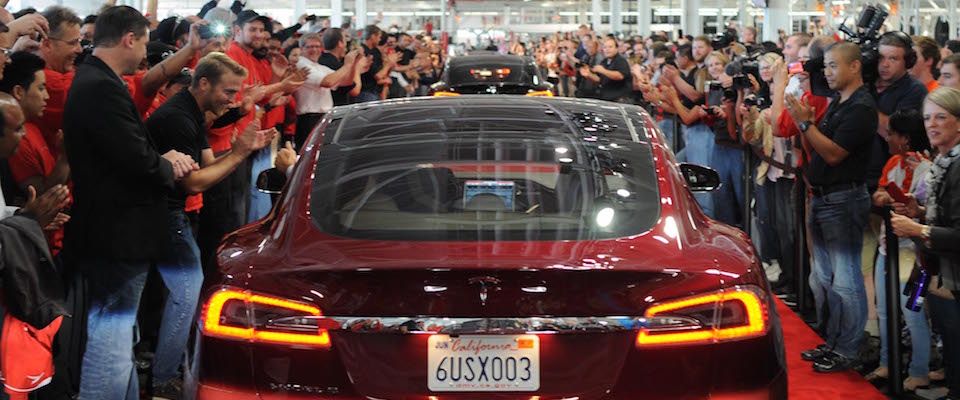One of the best ways to flaunt your Earth-hugging bona fides these days is to buy an electric car. It shows you’re willing to put your money—a lot of your money—where your mouth is, assuming your mouth spends a fair amount of time declaiming on global warming, atmospheric carbon emissions, nitrogen oxides, sulfur dioxides, and the sinister intentions of the global hydrocarbon extraction cabal. Buying a Tesla demonstrates you’re doing your part to keep our planet cool and green.
That’s what a lot of well-intentioned people think, anyway. But Richard Muller, a UC Berkeley physics professor emeritus and the co-founder of Berkeley Earth, a global warming research group, has a foursquare contrarian view. If you’ve purchased a Tesla, says Muller, you’ve been duped by the most polished and accomplished corporate salesman since Steven Jobs: the company’s CEO and founder, Elon Musk.
“The difference is that Jobs had a fantastic product line,” says Muller. “Musk is mostly selling hype. Teslas aren’t really doing anything beneficial for the planet. It’s more about conspicuous consumption. If you buy one, you’re either a rich guy who’s trying to look socially responsible, or you’re somebody who’s trying to come across as a rich guy.”
Muller’s views are at least partly shared by Ozzie Zehner, a former visiting scholar at Berkeley and the author of Green Illusions: the Dirty Secrets of Clean Energy and the Future of Environmentalism. They’re among a body of scientists and policy analysts who decry what they perceive as misplaced priorities in climate change response, particularly electric cars.
“That halo above electric cars is drooping a bit,” says Zehner, who has an engineering B.A. and a M.S. in Science and Technology Studies. “It’s becoming apparent that we were seduced by a sort of self-serving instrumental ignorance when it came to critically thinking about electric vehicles. The principal value of electric vehicles and hybrids is that they allow upper-middle class and wealthy drivers to absolve themselves from their environmental sins. It also might get them tax breaks, free parking, allowance to drive and HOV lanes, and some street cred among their friends.”
Notwithstanding the growing skepticism of these researchers, the electric car biz is going gangbusters: Tesla can’t keep up with orders and respected reviewers like Car and Driver consistently give their pricey vehicles five-star reviews. In mid-April, Tesla’s market valuation passed that of General Motors, to the dismay of skeptics like AutoNation CEO Mike Jackson, who called it “inexplicable,” since GM currently sells 130 times as many cars as the trendy Silicon Valley start-up.
And who knows, maybe the way toward a greener future starts with a hipper-than-thou status symbol.
To be sure, the marketplace is a reflection of desire as well as necessity, and valuation is often driven by the promise of growth rather than past success. And who knows, maybe the way toward a greener future starts with a hipper-than-thou status symbol. Rock star entrepreneur Musk, after all, isn’t just selling cars. He also has spun off home and commercial battery systems from his electric vehicle (EV) technology that, he says, will make the national energy grid more reliable and far less CO2-intensive.
Perhaps the sheen of Tesla’s expensive, stylish S (starting at $68,000) and X ($80,000) models, provided the sizzle to help drive sales for the entire EV sector, which rose 37 percent in 2016. Tesla, Nissan, Chevrolet, and Ford all sold over 10,000 all-electric cars in the United States last year, and all were priced at under $35,000. And Tesla will reportedly break out of its elite niche next year with the launch of the Model 3, its first car targeted at the middle-class consumer, which quickly garnered several-thousand pre-order deposits.
According to Muller, electric cars could reduce carbon emissions one day, but he stresses that they’re only as green as the grid from which they draw their juice. “So in California and some other parts of the West, they can make some nominal sense because we use a lot of natural gas, wind and solar,” Muller says. “But in the eastern U.S., where at least half of electrical energy comes from coal? No. The carbon burden is simply pushed from the car to the power plant. With coal-generated power, you could actually exacerbate carbon emissions by driving an electric car, particularly if you chose it over a hybrid or a fuel-efficient standard car.”
Moreover, electric vehicles remain bedeviled by an inherent technological challenge that may prove insurmountable: batteries. He believes the cost and fragility of batteries big and light enough to provide significant range will keep EVs too expensive to appeal to the world’s car-buying masses.
“Lithium batteries are a huge issue,” says Muller. “They’re not only initially expensive, but they’re vulnerable to damage from all the shaking and bouncing cars go through, and they have to be replaced every 100,000 miles. . . . Batteries are wonderful for storing energy for, say, wind, or solar projects. But they’re not so great as the primary power source for vehicles.”
Zehner, meanwhile, maintains electric vehicles have numerous hidden environmental costs that ultimately outweigh any potential environmental benefit.
“Using carbon emissions as a metric makes it easier for electrical vehicle proponents to create the illusion that their cars are somehow greener,” says Zehner, “But Carbon emissions are only one of many side effects we might use to measure human impact on the natural world. Energy extraction creates impacts that extend far beyond carbon dioxide emissions, including habitat devastation, radiation fallout risks [from nuclear power plants], and methane emissions. According to the National Academies of Science, the bulk of a vehicle’s impact comes from its construction, before you even drive it off the dealership lot. Electric vehicles require high-impact materials such as aluminum and cobalt, which is the reason these cars are so expensive. Just like other industrial goods, their high price tag ultimately reveals something about the fossil fuels used to create them.”
In fact, Zehner notes, the largest component of a lithium-ion battery is a specialized coal: graphite. “The mining industry [is] adding numerous coal mines just to supply Tesla’s Gigafactory with the coal hidden inside its batteries,” he contends.
For motorists who want to save both money and the biosphere, gas-electric hybrids are a much better choice than EVs, says Muller. Hybrid technology is largely perfected, resulting in cars that are extremely fuel-efficient, reasonably priced and have a better range.
It should be noted that at one point in Muller’s career he also expressed skepticism about global warming science, but he recanted his position in a widely circulated 2012 New York Times oped. He remains controversial in climate change circles because Berkeley Earth received money from Charles Koch to fund some of the research that ultimately led to Muller’s acceptance of anthropogenic climate change.
Having accepted that humans are causing the problem, however, he remains deeply irked by “solutions” he considers overblown, like electric cars.
“In the coming decades, most of projected warming is going to be due to carbon emissions from China, India, and less developed countries,” Muller says. “If the U.S. disappeared today, the rate of global warming would return to its current state within four years. So the best thing we can do in the United States isn’t buying Teslas—it’s setting examples for the major carbon emitters of tomorrow.” And, he adds, since China’s current main energy source is coal, EV cars could actually increase China’s apocalyptic air pollution and voluminous CO2 emissions. (He supports China’s move to next-gen nuclear power plants.)
“But over a couple of years, [EVs will] dig themselves out of that carbon deficit, particularly in regions with grids that rely on [renewable resources].”
Zehner’s dissent runs even deeper. He is particularly exasperated by EVs because he thinks their promotion ignores—unwittingly or purposely—the main drivers of biosphere degradation: human population and consumption.
“Electric vehicles do nothing to address either of these principal factors,” he says. “Instead, their construction and use depend on some of the most destructive and fossil-fuel intensive extraction techniques that we have ever created.”
Both Muller and Zehner believe the EV industry is currently in something of a bubble that will collapse under the weight of excessive expectations.
“The EV sector will peak and collapse long before there is an all-electric fleet or charging infrastructure to support it,” Zehner says. “That’s because the EV dream is based on energy laundering and subsidies from taxpayers, pensioners whose retirement accounts are vested in the associated companies, poor cobalt miners in the Congo, and the natural world. Eventually the scheme will become financially and materially untenable.”
Zehner adds that he “would not mind being wrong. It would be great news if these sports cars really do have the environmental benefits that many environmental groups praise.
But EVs still have plenty of supporters in the research and policy spheres, and Tim Lipman, the co-director of Cal’s Transportation Sustainability Research Center, is among them. Lipman agrees with Zehner that EVs impose more energy and carbon emission costs in their production than internal combustion engine (ICE) cars or hybrids, “But over a couple of years, they dig themselves out of that carbon deficit, particularly in regions with grids that rely on [renewable resources].”
Further, coal is in decline as a power source while alternative sources are ascendant. And while hybrids and smaller ICE cars may result in fewer net carbon emissions than EVs in those areas heavily reliant on coal, it’s usually a matter of degree rather than overwhelming superiority, says Lipman. It’s incumbent on environmentally concerned consumers to consider three separate factors when comparing EVs to other vehicles.
“You have to think about carbon emissions, certainly, but you also need to think about criteria pollutants: zone, nitrogen oxide, particulates. That stuff comes out at street level if you’re driving a gasoline-powered car or even a hybrid. By contrast, even [U.S.] coal-fired plants are pretty well regulated for criteria pollutants these days, and the pollutants they do produce are centralized at or near the plant and dispersed from tall smokestacks, so you don’t receive them right in your face in concentrated form.”
Energy security also must be taken into account, says Lipman. Even with domestic fracking, the U.S. still imported almost eight million barrels of oil a day in 2016, and most of that was refined for the use of vehicles with internal combustion engines.
“EVs effectively address all three of these concerns,” says Lipman.
To evaluate the relative emissions of EVs, hybrids and internal combustion vehicles on a state-by-state basis, go to the U.S. Department of Energy’s Alternative Fuels Data Center website.





















